Management of Industrial Relations: UK and Australia Comparison
VerifiedAdded on 2021/06/16
|12
|2683
|91
Report
AI Summary
This report provides a detailed comparison of the industrial relations (IR) systems of the United Kingdom and Australia. It begins with an overview of the UK's IR, highlighting key components such as its approach (minimal government interference), legislation (Trade Union Act, etc.), trade unions and associations (TUC), collective agreements, dispute resolution (ACAS), representation, and employee rights. The report then presents an overview of Australian IR, including its legislative framework (Fair Work Act), industrial instruments, and regulatory authorities. The core of the report contrasts the two systems, identifying similarities such as the presence of legislation and trade unions, while also highlighting key differences. These differences include dispute resolution mechanisms (ACAS in UK vs. tribunals in Australia), the degree of government intervention (minimal in UK vs. high in Australia), labor laws, and representation structures. The report concludes by emphasizing the impact of IR management on the labor market in both countries.

Running head: Management of Industrial Relation 1
MANAGEMENT OF INDUSTRIAL RELATION
Student Name
Institution
MANAGEMENT OF INDUSTRIAL RELATION
Student Name
Institution
Paraphrase This Document
Need a fresh take? Get an instant paraphrase of this document with our AI Paraphraser

Management of Industrial Relation 2
1. Introduction
Management of industrial relations is a multifaceted area that involves various players
and regulations. Various countries have their own government and legal regulation that control
inter-organizational and interpersonal relations. The IR can be explored based on various aspects
such as legal framework, associations, regulations and dispute resolutions. In analyzing the IR
United Kingdom and Australian IR can be compared based on elements and employment issues.
Clear differences can be observed between the IR of UK and Australia with clear similarities
also visible. The UK's approach to IR is generally traditional belief on non-government
interference as compared to full government intervention in case of Australian IR. One visible
similarity is the regulatory and legislative framework within both countries’ IR. The following
paper gives an overview of United Kingdom’s industrial relation comparing and contrasting both
counties’ IR.
Provide an overview of the IR system of a country or region of your
choice and compare and contrast it with the Australian system.
2. The overview of IR system of United Kingdom
The industrial relation of the United Kingdom has been of significance in relation to
employment. The overview of industrial relations of the United Kingdom is characterized by a
number of components. These components can be categorized into approach, legislation, unions
and associations, dispute resolution and representation.
1. Introduction
Management of industrial relations is a multifaceted area that involves various players
and regulations. Various countries have their own government and legal regulation that control
inter-organizational and interpersonal relations. The IR can be explored based on various aspects
such as legal framework, associations, regulations and dispute resolutions. In analyzing the IR
United Kingdom and Australian IR can be compared based on elements and employment issues.
Clear differences can be observed between the IR of UK and Australia with clear similarities
also visible. The UK's approach to IR is generally traditional belief on non-government
interference as compared to full government intervention in case of Australian IR. One visible
similarity is the regulatory and legislative framework within both countries’ IR. The following
paper gives an overview of United Kingdom’s industrial relation comparing and contrasting both
counties’ IR.
Provide an overview of the IR system of a country or region of your
choice and compare and contrast it with the Australian system.
2. The overview of IR system of United Kingdom
The industrial relation of the United Kingdom has been of significance in relation to
employment. The overview of industrial relations of the United Kingdom is characterized by a
number of components. These components can be categorized into approach, legislation, unions
and associations, dispute resolution and representation.
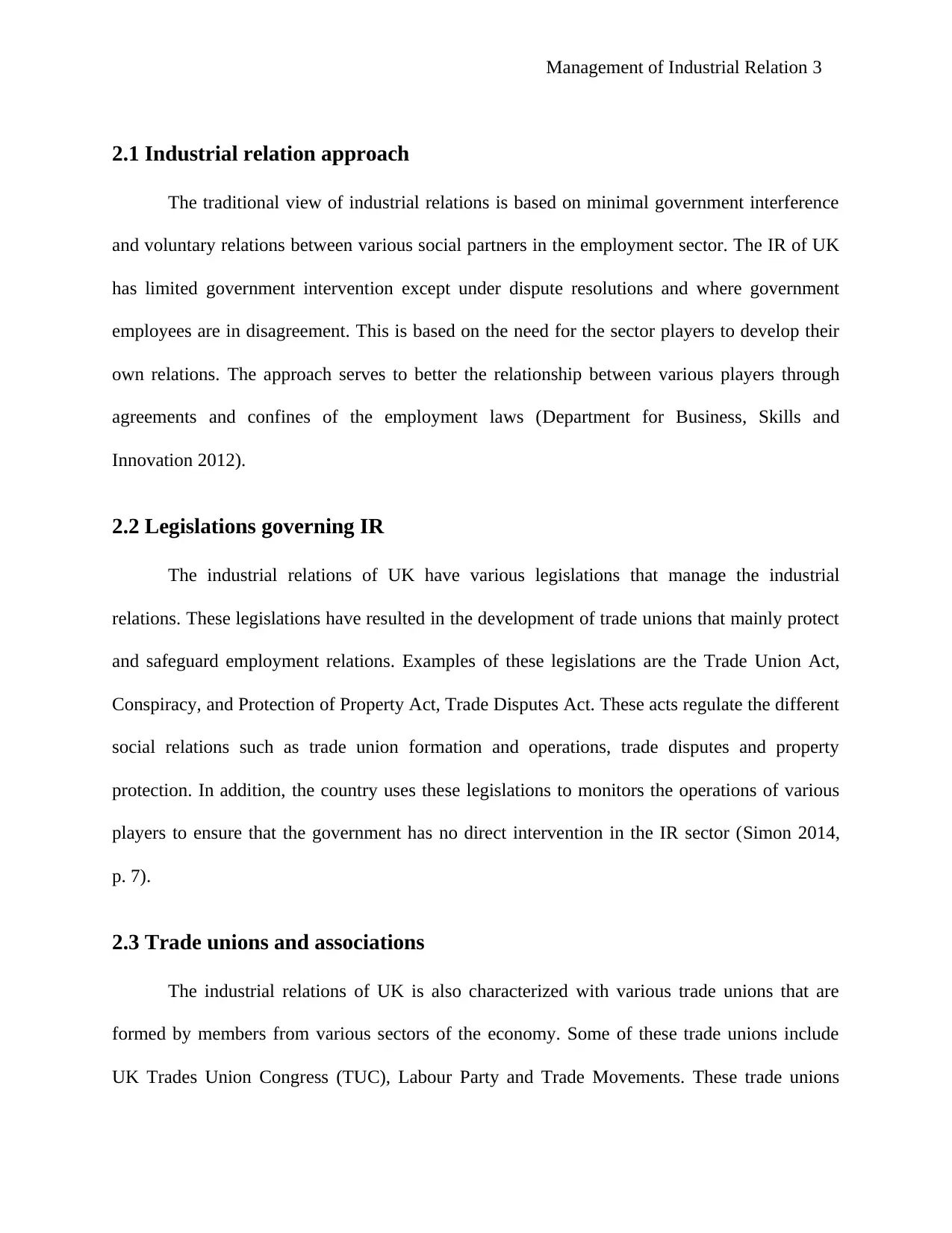
Management of Industrial Relation 3
2.1 Industrial relation approach
The traditional view of industrial relations is based on minimal government interference
and voluntary relations between various social partners in the employment sector. The IR of UK
has limited government intervention except under dispute resolutions and where government
employees are in disagreement. This is based on the need for the sector players to develop their
own relations. The approach serves to better the relationship between various players through
agreements and confines of the employment laws (Department for Business, Skills and
Innovation 2012).
2.2 Legislations governing IR
The industrial relations of UK have various legislations that manage the industrial
relations. These legislations have resulted in the development of trade unions that mainly protect
and safeguard employment relations. Examples of these legislations are the Trade Union Act,
Conspiracy, and Protection of Property Act, Trade Disputes Act. These acts regulate the different
social relations such as trade union formation and operations, trade disputes and property
protection. In addition, the country uses these legislations to monitors the operations of various
players to ensure that the government has no direct intervention in the IR sector (Simon 2014,
p. 7).
2.3 Trade unions and associations
The industrial relations of UK is also characterized with various trade unions that are
formed by members from various sectors of the economy. Some of these trade unions include
UK Trades Union Congress (TUC), Labour Party and Trade Movements. These trade unions
2.1 Industrial relation approach
The traditional view of industrial relations is based on minimal government interference
and voluntary relations between various social partners in the employment sector. The IR of UK
has limited government intervention except under dispute resolutions and where government
employees are in disagreement. This is based on the need for the sector players to develop their
own relations. The approach serves to better the relationship between various players through
agreements and confines of the employment laws (Department for Business, Skills and
Innovation 2012).
2.2 Legislations governing IR
The industrial relations of UK have various legislations that manage the industrial
relations. These legislations have resulted in the development of trade unions that mainly protect
and safeguard employment relations. Examples of these legislations are the Trade Union Act,
Conspiracy, and Protection of Property Act, Trade Disputes Act. These acts regulate the different
social relations such as trade union formation and operations, trade disputes and property
protection. In addition, the country uses these legislations to monitors the operations of various
players to ensure that the government has no direct intervention in the IR sector (Simon 2014,
p. 7).
2.3 Trade unions and associations
The industrial relations of UK is also characterized with various trade unions that are
formed by members from various sectors of the economy. Some of these trade unions include
UK Trades Union Congress (TUC), Labour Party and Trade Movements. These trade unions
⊘ This is a preview!⊘
Do you want full access?
Subscribe today to unlock all pages.

Trusted by 1+ million students worldwide
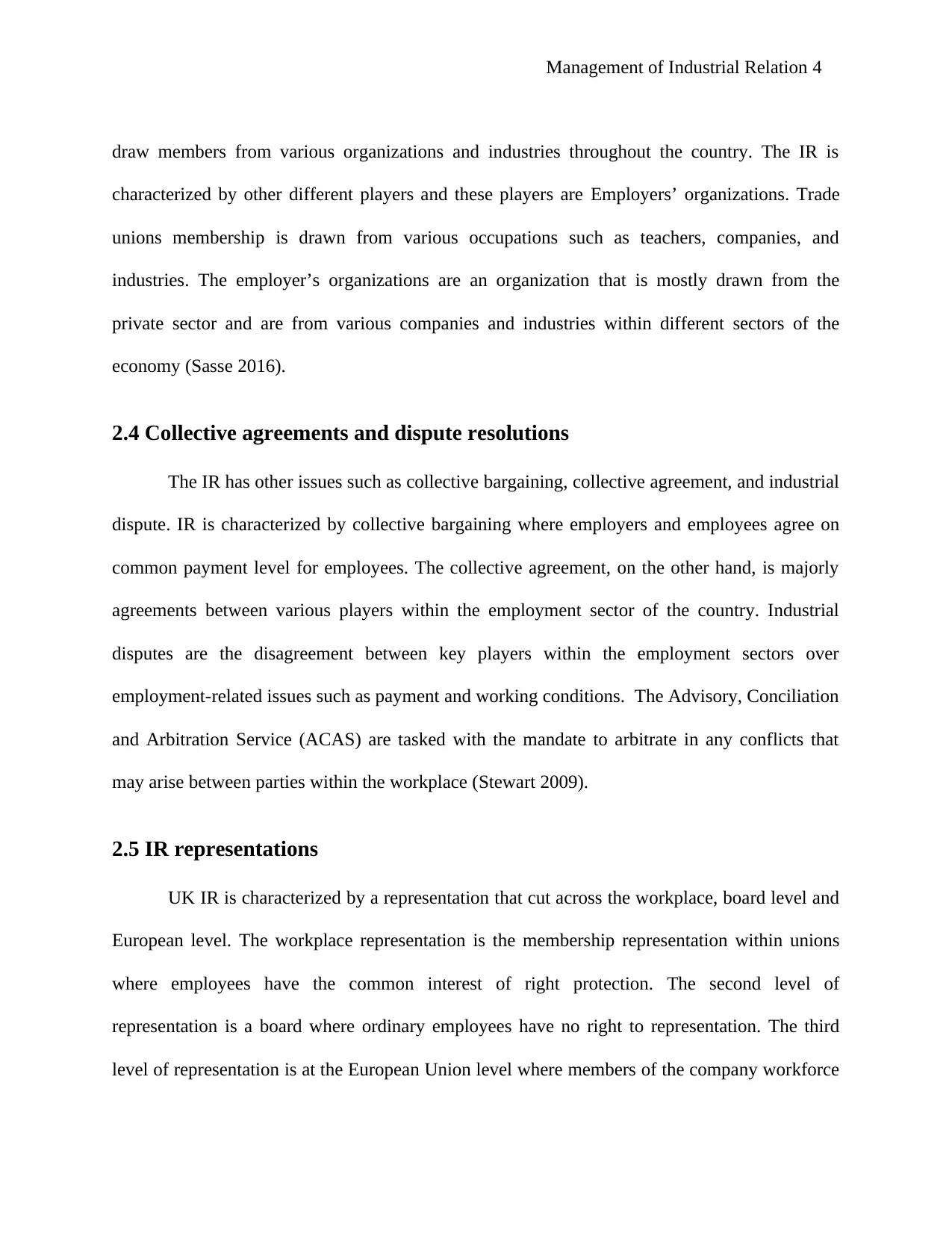
Management of Industrial Relation 4
draw members from various organizations and industries throughout the country. The IR is
characterized by other different players and these players are Employers’ organizations. Trade
unions membership is drawn from various occupations such as teachers, companies, and
industries. The employer’s organizations are an organization that is mostly drawn from the
private sector and are from various companies and industries within different sectors of the
economy (Sasse 2016).
2.4 Collective agreements and dispute resolutions
The IR has other issues such as collective bargaining, collective agreement, and industrial
dispute. IR is characterized by collective bargaining where employers and employees agree on
common payment level for employees. The collective agreement, on the other hand, is majorly
agreements between various players within the employment sector of the country. Industrial
disputes are the disagreement between key players within the employment sectors over
employment-related issues such as payment and working conditions. The Advisory, Conciliation
and Arbitration Service (ACAS) are tasked with the mandate to arbitrate in any conflicts that
may arise between parties within the workplace (Stewart 2009).
2.5 IR representations
UK IR is characterized by a representation that cut across the workplace, board level and
European level. The workplace representation is the membership representation within unions
where employees have the common interest of right protection. The second level of
representation is a board where ordinary employees have no right to representation. The third
level of representation is at the European Union level where members of the company workforce
draw members from various organizations and industries throughout the country. The IR is
characterized by other different players and these players are Employers’ organizations. Trade
unions membership is drawn from various occupations such as teachers, companies, and
industries. The employer’s organizations are an organization that is mostly drawn from the
private sector and are from various companies and industries within different sectors of the
economy (Sasse 2016).
2.4 Collective agreements and dispute resolutions
The IR has other issues such as collective bargaining, collective agreement, and industrial
dispute. IR is characterized by collective bargaining where employers and employees agree on
common payment level for employees. The collective agreement, on the other hand, is majorly
agreements between various players within the employment sector of the country. Industrial
disputes are the disagreement between key players within the employment sectors over
employment-related issues such as payment and working conditions. The Advisory, Conciliation
and Arbitration Service (ACAS) are tasked with the mandate to arbitrate in any conflicts that
may arise between parties within the workplace (Stewart 2009).
2.5 IR representations
UK IR is characterized by a representation that cut across the workplace, board level and
European level. The workplace representation is the membership representation within unions
where employees have the common interest of right protection. The second level of
representation is a board where ordinary employees have no right to representation. The third
level of representation is at the European Union level where members of the company workforce
Paraphrase This Document
Need a fresh take? Get an instant paraphrase of this document with our AI Paraphraser
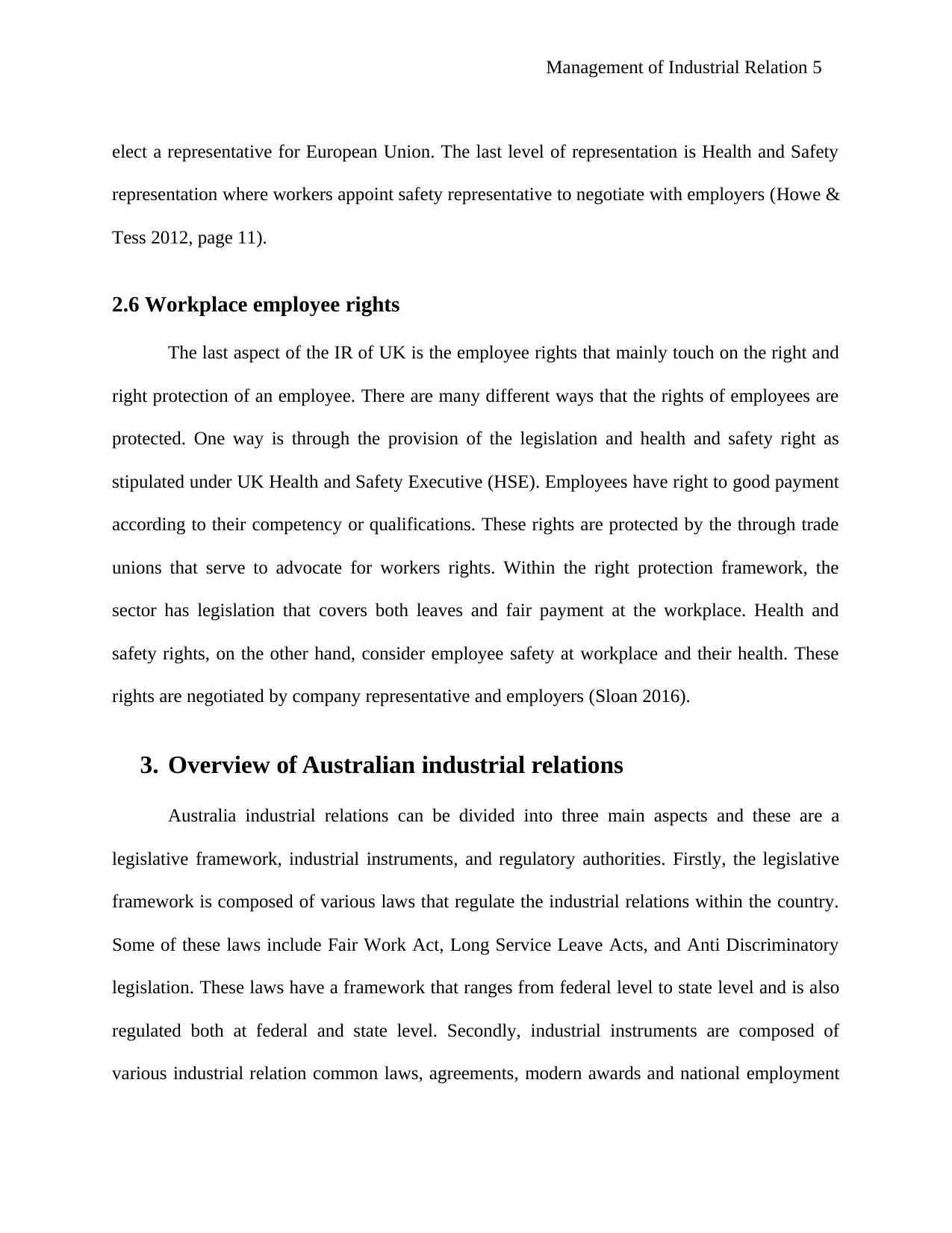
Management of Industrial Relation 5
elect a representative for European Union. The last level of representation is Health and Safety
representation where workers appoint safety representative to negotiate with employers (Howe &
Tess 2012, page 11).
2.6 Workplace employee rights
The last aspect of the IR of UK is the employee rights that mainly touch on the right and
right protection of an employee. There are many different ways that the rights of employees are
protected. One way is through the provision of the legislation and health and safety right as
stipulated under UK Health and Safety Executive (HSE). Employees have right to good payment
according to their competency or qualifications. These rights are protected by the through trade
unions that serve to advocate for workers rights. Within the right protection framework, the
sector has legislation that covers both leaves and fair payment at the workplace. Health and
safety rights, on the other hand, consider employee safety at workplace and their health. These
rights are negotiated by company representative and employers (Sloan 2016).
3. Overview of Australian industrial relations
Australia industrial relations can be divided into three main aspects and these are a
legislative framework, industrial instruments, and regulatory authorities. Firstly, the legislative
framework is composed of various laws that regulate the industrial relations within the country.
Some of these laws include Fair Work Act, Long Service Leave Acts, and Anti Discriminatory
legislation. These laws have a framework that ranges from federal level to state level and is also
regulated both at federal and state level. Secondly, industrial instruments are composed of
various industrial relation common laws, agreements, modern awards and national employment
elect a representative for European Union. The last level of representation is Health and Safety
representation where workers appoint safety representative to negotiate with employers (Howe &
Tess 2012, page 11).
2.6 Workplace employee rights
The last aspect of the IR of UK is the employee rights that mainly touch on the right and
right protection of an employee. There are many different ways that the rights of employees are
protected. One way is through the provision of the legislation and health and safety right as
stipulated under UK Health and Safety Executive (HSE). Employees have right to good payment
according to their competency or qualifications. These rights are protected by the through trade
unions that serve to advocate for workers rights. Within the right protection framework, the
sector has legislation that covers both leaves and fair payment at the workplace. Health and
safety rights, on the other hand, consider employee safety at workplace and their health. These
rights are negotiated by company representative and employers (Sloan 2016).
3. Overview of Australian industrial relations
Australia industrial relations can be divided into three main aspects and these are a
legislative framework, industrial instruments, and regulatory authorities. Firstly, the legislative
framework is composed of various laws that regulate the industrial relations within the country.
Some of these laws include Fair Work Act, Long Service Leave Acts, and Anti Discriminatory
legislation. These laws have a framework that ranges from federal level to state level and is also
regulated both at federal and state level. Secondly, industrial instruments are composed of
various industrial relation common laws, agreements, modern awards and national employment
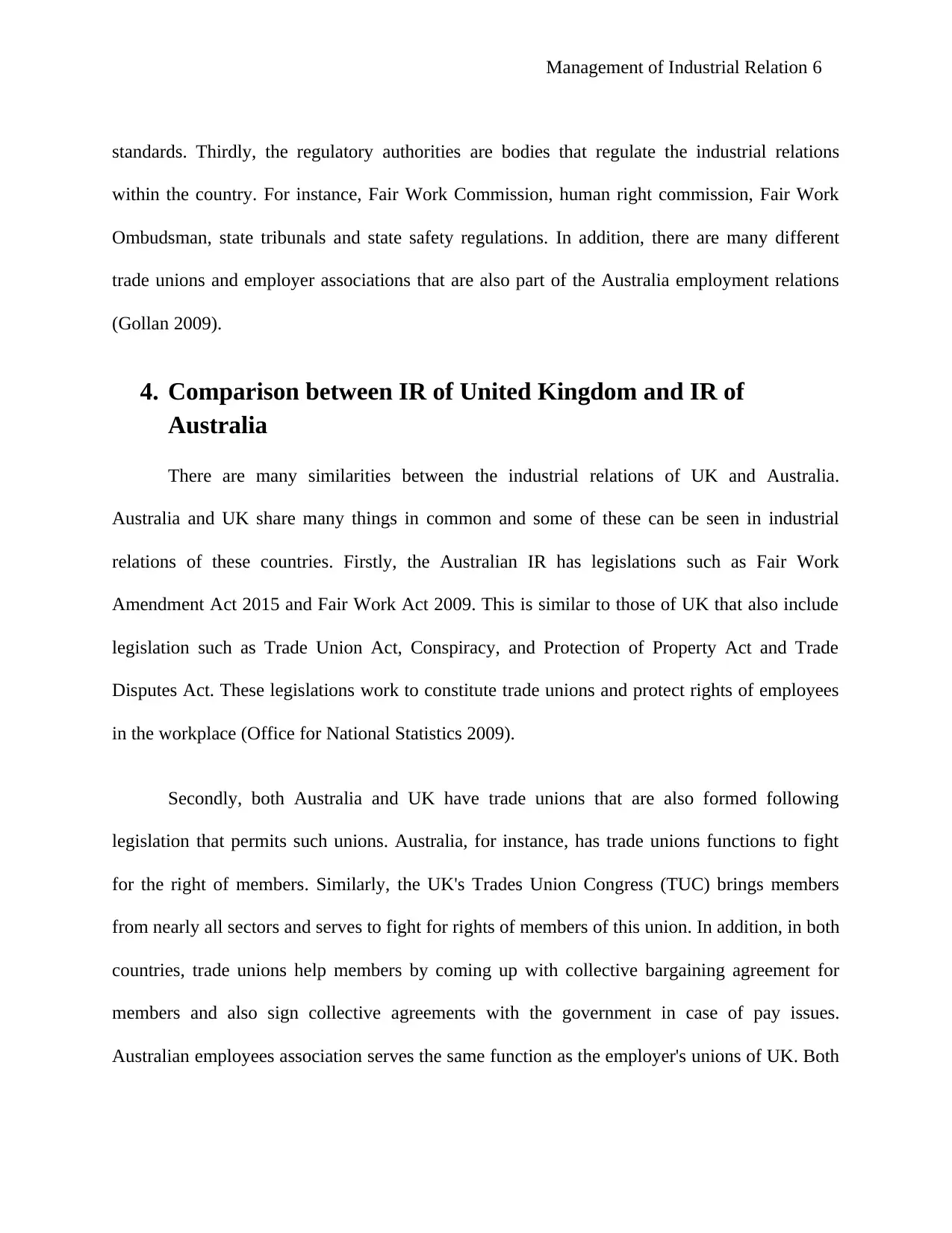
Management of Industrial Relation 6
standards. Thirdly, the regulatory authorities are bodies that regulate the industrial relations
within the country. For instance, Fair Work Commission, human right commission, Fair Work
Ombudsman, state tribunals and state safety regulations. In addition, there are many different
trade unions and employer associations that are also part of the Australia employment relations
(Gollan 2009).
4. Comparison between IR of United Kingdom and IR of
Australia
There are many similarities between the industrial relations of UK and Australia.
Australia and UK share many things in common and some of these can be seen in industrial
relations of these countries. Firstly, the Australian IR has legislations such as Fair Work
Amendment Act 2015 and Fair Work Act 2009. This is similar to those of UK that also include
legislation such as Trade Union Act, Conspiracy, and Protection of Property Act and Trade
Disputes Act. These legislations work to constitute trade unions and protect rights of employees
in the workplace (Office for National Statistics 2009).
Secondly, both Australia and UK have trade unions that are also formed following
legislation that permits such unions. Australia, for instance, has trade unions functions to fight
for the right of members. Similarly, the UK's Trades Union Congress (TUC) brings members
from nearly all sectors and serves to fight for rights of members of this union. In addition, in both
countries, trade unions help members by coming up with collective bargaining agreement for
members and also sign collective agreements with the government in case of pay issues.
Australian employees association serves the same function as the employer's unions of UK. Both
standards. Thirdly, the regulatory authorities are bodies that regulate the industrial relations
within the country. For instance, Fair Work Commission, human right commission, Fair Work
Ombudsman, state tribunals and state safety regulations. In addition, there are many different
trade unions and employer associations that are also part of the Australia employment relations
(Gollan 2009).
4. Comparison between IR of United Kingdom and IR of
Australia
There are many similarities between the industrial relations of UK and Australia.
Australia and UK share many things in common and some of these can be seen in industrial
relations of these countries. Firstly, the Australian IR has legislations such as Fair Work
Amendment Act 2015 and Fair Work Act 2009. This is similar to those of UK that also include
legislation such as Trade Union Act, Conspiracy, and Protection of Property Act and Trade
Disputes Act. These legislations work to constitute trade unions and protect rights of employees
in the workplace (Office for National Statistics 2009).
Secondly, both Australia and UK have trade unions that are also formed following
legislation that permits such unions. Australia, for instance, has trade unions functions to fight
for the right of members. Similarly, the UK's Trades Union Congress (TUC) brings members
from nearly all sectors and serves to fight for rights of members of this union. In addition, in both
countries, trade unions help members by coming up with collective bargaining agreement for
members and also sign collective agreements with the government in case of pay issues.
Australian employees association serves the same function as the employer's unions of UK. Both
⊘ This is a preview!⊘
Do you want full access?
Subscribe today to unlock all pages.

Trusted by 1+ million students worldwide
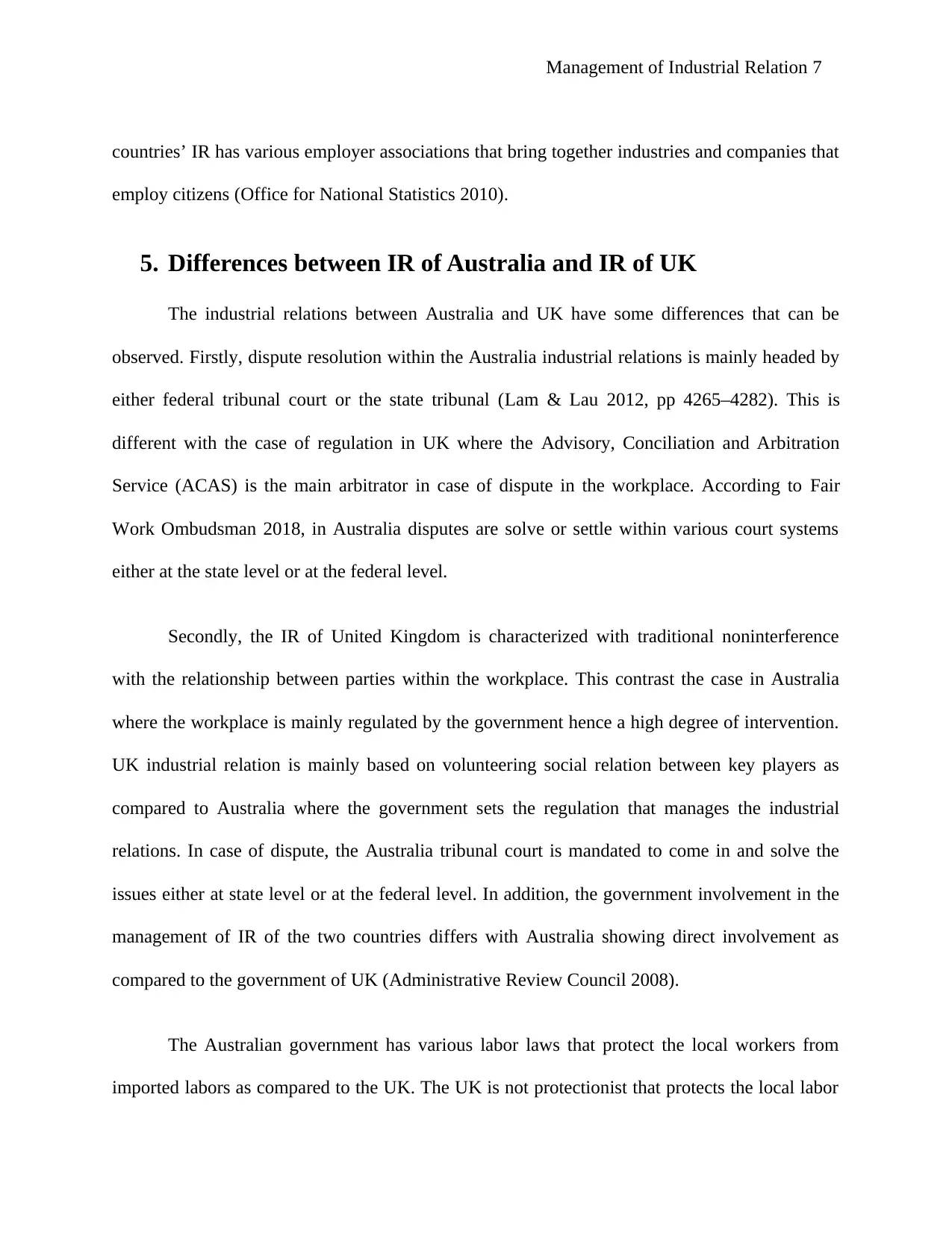
Management of Industrial Relation 7
countries’ IR has various employer associations that bring together industries and companies that
employ citizens (Office for National Statistics 2010).
5. Differences between IR of Australia and IR of UK
The industrial relations between Australia and UK have some differences that can be
observed. Firstly, dispute resolution within the Australia industrial relations is mainly headed by
either federal tribunal court or the state tribunal (Lam & Lau 2012, pp 4265–4282). This is
different with the case of regulation in UK where the Advisory, Conciliation and Arbitration
Service (ACAS) is the main arbitrator in case of dispute in the workplace. According to Fair
Work Ombudsman 2018, in Australia disputes are solve or settle within various court systems
either at the state level or at the federal level.
Secondly, the IR of United Kingdom is characterized with traditional noninterference
with the relationship between parties within the workplace. This contrast the case in Australia
where the workplace is mainly regulated by the government hence a high degree of intervention.
UK industrial relation is mainly based on volunteering social relation between key players as
compared to Australia where the government sets the regulation that manages the industrial
relations. In case of dispute, the Australia tribunal court is mandated to come in and solve the
issues either at state level or at the federal level. In addition, the government involvement in the
management of IR of the two countries differs with Australia showing direct involvement as
compared to the government of UK (Administrative Review Council 2008).
The Australian government has various labor laws that protect the local workers from
imported labors as compared to the UK. The UK is not protectionist that protects the local labor
countries’ IR has various employer associations that bring together industries and companies that
employ citizens (Office for National Statistics 2010).
5. Differences between IR of Australia and IR of UK
The industrial relations between Australia and UK have some differences that can be
observed. Firstly, dispute resolution within the Australia industrial relations is mainly headed by
either federal tribunal court or the state tribunal (Lam & Lau 2012, pp 4265–4282). This is
different with the case of regulation in UK where the Advisory, Conciliation and Arbitration
Service (ACAS) is the main arbitrator in case of dispute in the workplace. According to Fair
Work Ombudsman 2018, in Australia disputes are solve or settle within various court systems
either at the state level or at the federal level.
Secondly, the IR of United Kingdom is characterized with traditional noninterference
with the relationship between parties within the workplace. This contrast the case in Australia
where the workplace is mainly regulated by the government hence a high degree of intervention.
UK industrial relation is mainly based on volunteering social relation between key players as
compared to Australia where the government sets the regulation that manages the industrial
relations. In case of dispute, the Australia tribunal court is mandated to come in and solve the
issues either at state level or at the federal level. In addition, the government involvement in the
management of IR of the two countries differs with Australia showing direct involvement as
compared to the government of UK (Administrative Review Council 2008).
The Australian government has various labor laws that protect the local workers from
imported labors as compared to the UK. The UK is not protectionist that protects the local labor
Paraphrase This Document
Need a fresh take? Get an instant paraphrase of this document with our AI Paraphraser
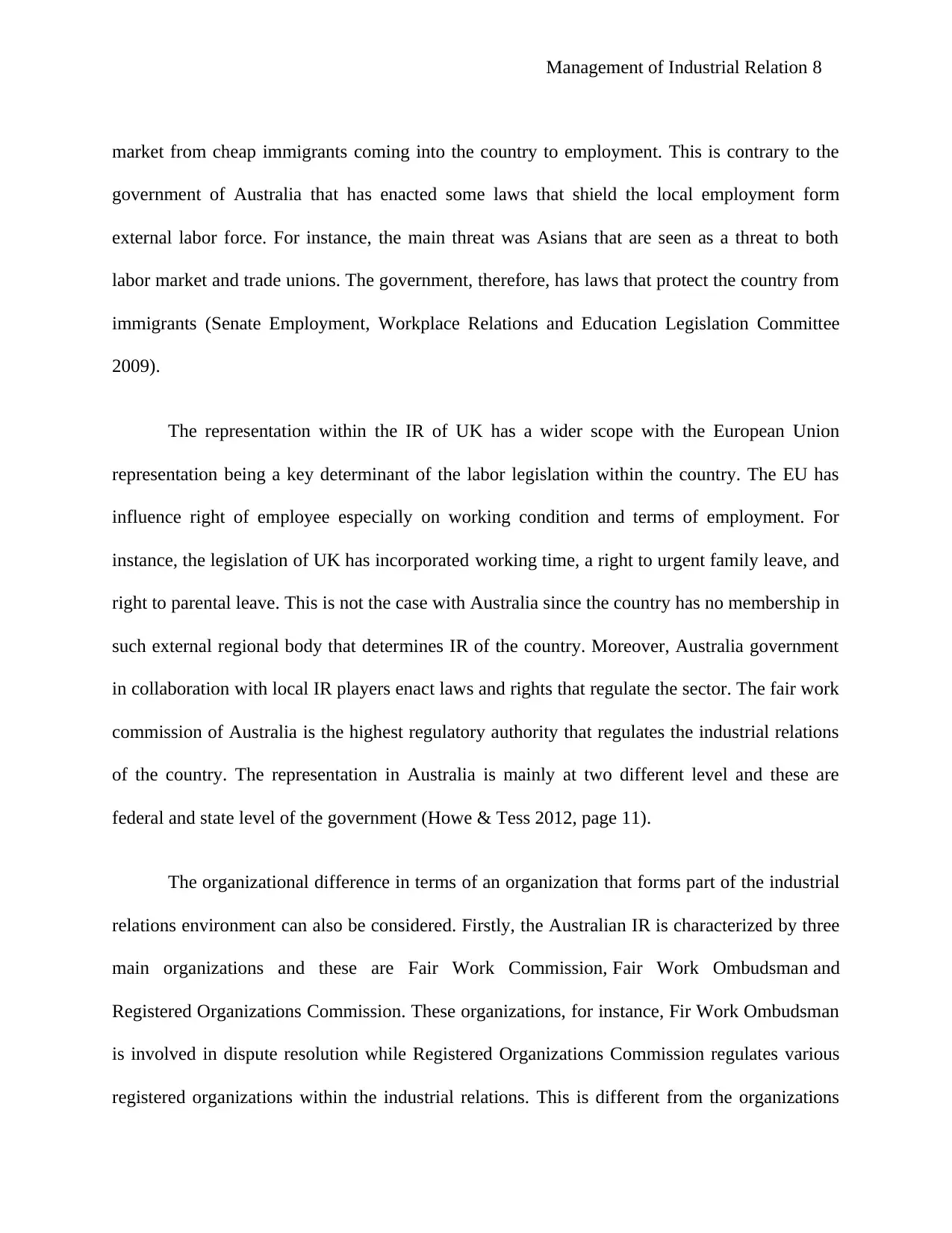
Management of Industrial Relation 8
market from cheap immigrants coming into the country to employment. This is contrary to the
government of Australia that has enacted some laws that shield the local employment form
external labor force. For instance, the main threat was Asians that are seen as a threat to both
labor market and trade unions. The government, therefore, has laws that protect the country from
immigrants (Senate Employment, Workplace Relations and Education Legislation Committee
2009).
The representation within the IR of UK has a wider scope with the European Union
representation being a key determinant of the labor legislation within the country. The EU has
influence right of employee especially on working condition and terms of employment. For
instance, the legislation of UK has incorporated working time, a right to urgent family leave, and
right to parental leave. This is not the case with Australia since the country has no membership in
such external regional body that determines IR of the country. Moreover, Australia government
in collaboration with local IR players enact laws and rights that regulate the sector. The fair work
commission of Australia is the highest regulatory authority that regulates the industrial relations
of the country. The representation in Australia is mainly at two different level and these are
federal and state level of the government (Howe & Tess 2012, page 11).
The organizational difference in terms of an organization that forms part of the industrial
relations environment can also be considered. Firstly, the Australian IR is characterized by three
main organizations and these are Fair Work Commission, Fair Work Ombudsman and
Registered Organizations Commission. These organizations, for instance, Fir Work Ombudsman
is involved in dispute resolution while Registered Organizations Commission regulates various
registered organizations within the industrial relations. This is different from the organizations
market from cheap immigrants coming into the country to employment. This is contrary to the
government of Australia that has enacted some laws that shield the local employment form
external labor force. For instance, the main threat was Asians that are seen as a threat to both
labor market and trade unions. The government, therefore, has laws that protect the country from
immigrants (Senate Employment, Workplace Relations and Education Legislation Committee
2009).
The representation within the IR of UK has a wider scope with the European Union
representation being a key determinant of the labor legislation within the country. The EU has
influence right of employee especially on working condition and terms of employment. For
instance, the legislation of UK has incorporated working time, a right to urgent family leave, and
right to parental leave. This is not the case with Australia since the country has no membership in
such external regional body that determines IR of the country. Moreover, Australia government
in collaboration with local IR players enact laws and rights that regulate the sector. The fair work
commission of Australia is the highest regulatory authority that regulates the industrial relations
of the country. The representation in Australia is mainly at two different level and these are
federal and state level of the government (Howe & Tess 2012, page 11).
The organizational difference in terms of an organization that forms part of the industrial
relations environment can also be considered. Firstly, the Australian IR is characterized by three
main organizations and these are Fair Work Commission, Fair Work Ombudsman and
Registered Organizations Commission. These organizations, for instance, Fir Work Ombudsman
is involved in dispute resolution while Registered Organizations Commission regulates various
registered organizations within the industrial relations. This is different from the organizations
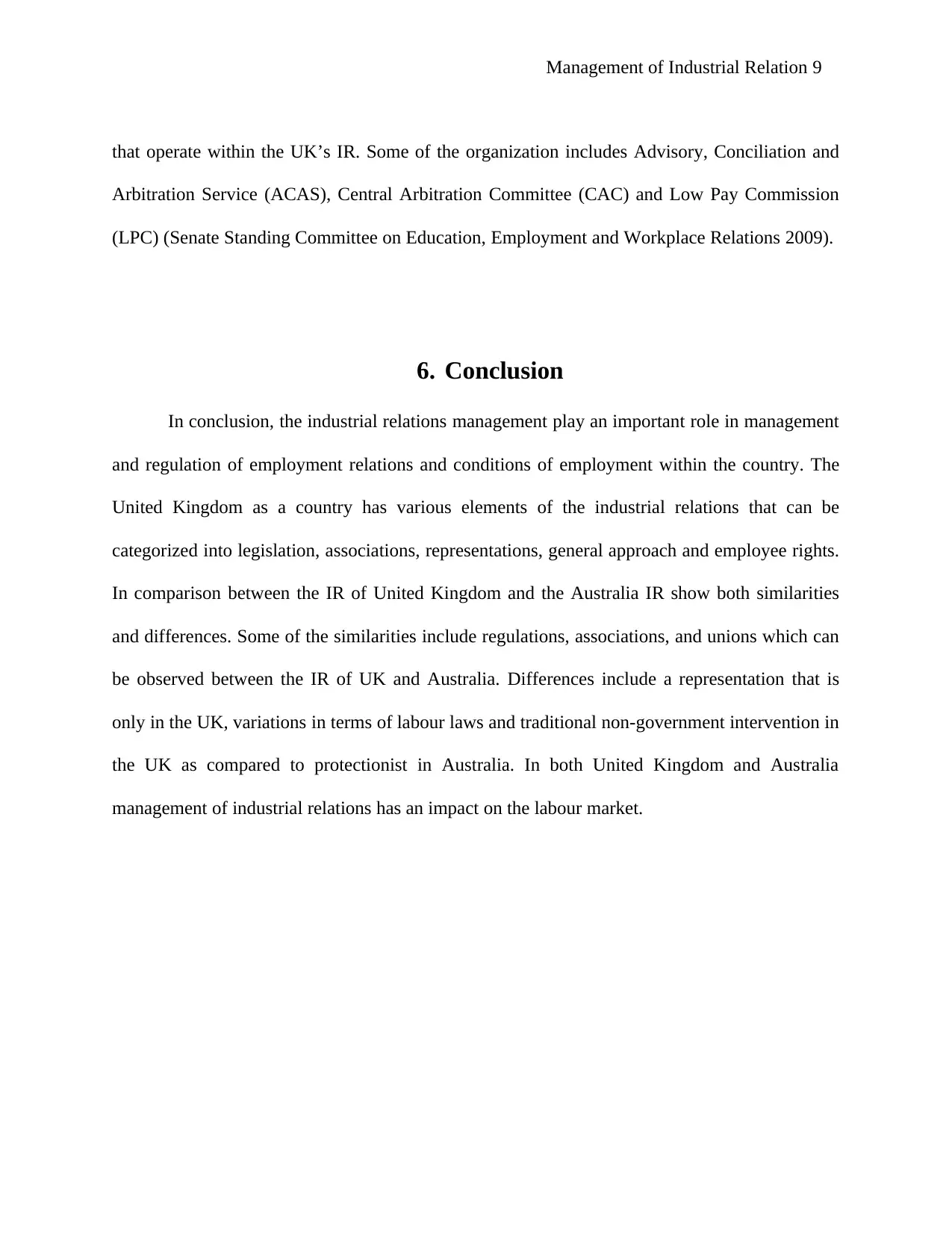
Management of Industrial Relation 9
that operate within the UK’s IR. Some of the organization includes Advisory, Conciliation and
Arbitration Service (ACAS), Central Arbitration Committee (CAC) and Low Pay Commission
(LPC) (Senate Standing Committee on Education, Employment and Workplace Relations 2009).
6. Conclusion
In conclusion, the industrial relations management play an important role in management
and regulation of employment relations and conditions of employment within the country. The
United Kingdom as a country has various elements of the industrial relations that can be
categorized into legislation, associations, representations, general approach and employee rights.
In comparison between the IR of United Kingdom and the Australia IR show both similarities
and differences. Some of the similarities include regulations, associations, and unions which can
be observed between the IR of UK and Australia. Differences include a representation that is
only in the UK, variations in terms of labour laws and traditional non-government intervention in
the UK as compared to protectionist in Australia. In both United Kingdom and Australia
management of industrial relations has an impact on the labour market.
that operate within the UK’s IR. Some of the organization includes Advisory, Conciliation and
Arbitration Service (ACAS), Central Arbitration Committee (CAC) and Low Pay Commission
(LPC) (Senate Standing Committee on Education, Employment and Workplace Relations 2009).
6. Conclusion
In conclusion, the industrial relations management play an important role in management
and regulation of employment relations and conditions of employment within the country. The
United Kingdom as a country has various elements of the industrial relations that can be
categorized into legislation, associations, representations, general approach and employee rights.
In comparison between the IR of United Kingdom and the Australia IR show both similarities
and differences. Some of the similarities include regulations, associations, and unions which can
be observed between the IR of UK and Australia. Differences include a representation that is
only in the UK, variations in terms of labour laws and traditional non-government intervention in
the UK as compared to protectionist in Australia. In both United Kingdom and Australia
management of industrial relations has an impact on the labour market.
⊘ This is a preview!⊘
Do you want full access?
Subscribe today to unlock all pages.

Trusted by 1+ million students worldwide

Management of Industrial Relation 10
7. References
Administrative Review Council, (May 2008) The Coercive Information-Gathering Powers of
Government Agencies, Report no. 48.
Department for Business, Skills, and Innovation (BIS) (2012) Trade Union Membership 2011,
Nikki Brownlie. http://www.bis.gov.uk/assets/biscore/employment-matters/docs/t/12-p77-trade
union-membership-2011.pdf [Accessed on 02 January 2013]
Fair Work Ombudsman, (2018) Effective dispute resolution: Page reference No: 2386, available
at https://www.fairwork.gov.au/how-we-will-help/templates-and-guides/best-practice-guides/
effective-dispute-resolution [Accessed on 23 April 2018]
Gollan, P. J. (2009) Australian industrial relations reform in perspective: Beyond Work Choices
and future prospects under the. Fair Work Act 2009 Asia Pacific Journal of Human Resources,
vol.43, no. 3
Howe, J. & Tess, H. (2012) The Use of Enforceable Undertakings as a Strategic Labour Law
Compliance Strategy, Centre for Employment and Labour Relations Law, University of
Melbourne (draft unpublished 2012), page 11.
Lam, L.W. & Lau, D.C. (2012) Feeling lonely at work: investigating the consequences of
unsatisfactory workplace relationships. The International Journal of Human Resource
Management, vol.23, no.20, pp 4265–4282
7. References
Administrative Review Council, (May 2008) The Coercive Information-Gathering Powers of
Government Agencies, Report no. 48.
Department for Business, Skills, and Innovation (BIS) (2012) Trade Union Membership 2011,
Nikki Brownlie. http://www.bis.gov.uk/assets/biscore/employment-matters/docs/t/12-p77-trade
union-membership-2011.pdf [Accessed on 02 January 2013]
Fair Work Ombudsman, (2018) Effective dispute resolution: Page reference No: 2386, available
at https://www.fairwork.gov.au/how-we-will-help/templates-and-guides/best-practice-guides/
effective-dispute-resolution [Accessed on 23 April 2018]
Gollan, P. J. (2009) Australian industrial relations reform in perspective: Beyond Work Choices
and future prospects under the. Fair Work Act 2009 Asia Pacific Journal of Human Resources,
vol.43, no. 3
Howe, J. & Tess, H. (2012) The Use of Enforceable Undertakings as a Strategic Labour Law
Compliance Strategy, Centre for Employment and Labour Relations Law, University of
Melbourne (draft unpublished 2012), page 11.
Lam, L.W. & Lau, D.C. (2012) Feeling lonely at work: investigating the consequences of
unsatisfactory workplace relationships. The International Journal of Human Resource
Management, vol.23, no.20, pp 4265–4282
Paraphrase This Document
Need a fresh take? Get an instant paraphrase of this document with our AI Paraphraser

Management of Industrial Relation 11
Office for National Statistics (ONS) (2009) Labour disputes in 2008, Economic and Labour
Market Review, Vol. 3, No. 6, available at
http://www.statistics.gov.uk/elmr/06_09/downloads/ELMR_Jun09.pdf [Accessed on 13
November 2015]
Office for National Statistics (ONS) (2010) Labour disputes in 2009, Economic and Labour
Market Review, Vol. 4, No. 6, available at
http://www.statistics.gov.uk/elmr/06_10/downloads/ELMR-Jun10.pdf [Accessed on 20
November 2013]
Sasse, S. (2016) Your Right to Work: The Employment Policy of a Truly Liberal Government’
The Institute of Public Affairs.
Simon, H. (2014) Honeyball and Bowers' Textbook of Employment Law. Oxford University
Press. p. 7. Available at https://books.google.com/books?id=Sdb1AwAAQBAJ&pg=PA7
[Accessed on 24 April 2015]
Sloan, J. (2016) Enterprise bargaining set to boldly go way of the dodo’ The Australian
Available at http://www.theaustralian.com.au/opinion/columnists/judith-sloan/ enterprise-
bargaining-set-to-boldly-go-way-of-the-dodo/news-story/0d843ce38 0ebb98ba8eb159338056da9
[accessed on 27 August 2016]
Senate Employment, Workplace Relations, and Education Legislation Committee (2009) Fair
Work Bill 2008 (Provisions), 27 February. Canberra: SEWRELC.
Office for National Statistics (ONS) (2009) Labour disputes in 2008, Economic and Labour
Market Review, Vol. 3, No. 6, available at
http://www.statistics.gov.uk/elmr/06_09/downloads/ELMR_Jun09.pdf [Accessed on 13
November 2015]
Office for National Statistics (ONS) (2010) Labour disputes in 2009, Economic and Labour
Market Review, Vol. 4, No. 6, available at
http://www.statistics.gov.uk/elmr/06_10/downloads/ELMR-Jun10.pdf [Accessed on 20
November 2013]
Sasse, S. (2016) Your Right to Work: The Employment Policy of a Truly Liberal Government’
The Institute of Public Affairs.
Simon, H. (2014) Honeyball and Bowers' Textbook of Employment Law. Oxford University
Press. p. 7. Available at https://books.google.com/books?id=Sdb1AwAAQBAJ&pg=PA7
[Accessed on 24 April 2015]
Sloan, J. (2016) Enterprise bargaining set to boldly go way of the dodo’ The Australian
Available at http://www.theaustralian.com.au/opinion/columnists/judith-sloan/ enterprise-
bargaining-set-to-boldly-go-way-of-the-dodo/news-story/0d843ce38 0ebb98ba8eb159338056da9
[accessed on 27 August 2016]
Senate Employment, Workplace Relations, and Education Legislation Committee (2009) Fair
Work Bill 2008 (Provisions), 27 February. Canberra: SEWRELC.
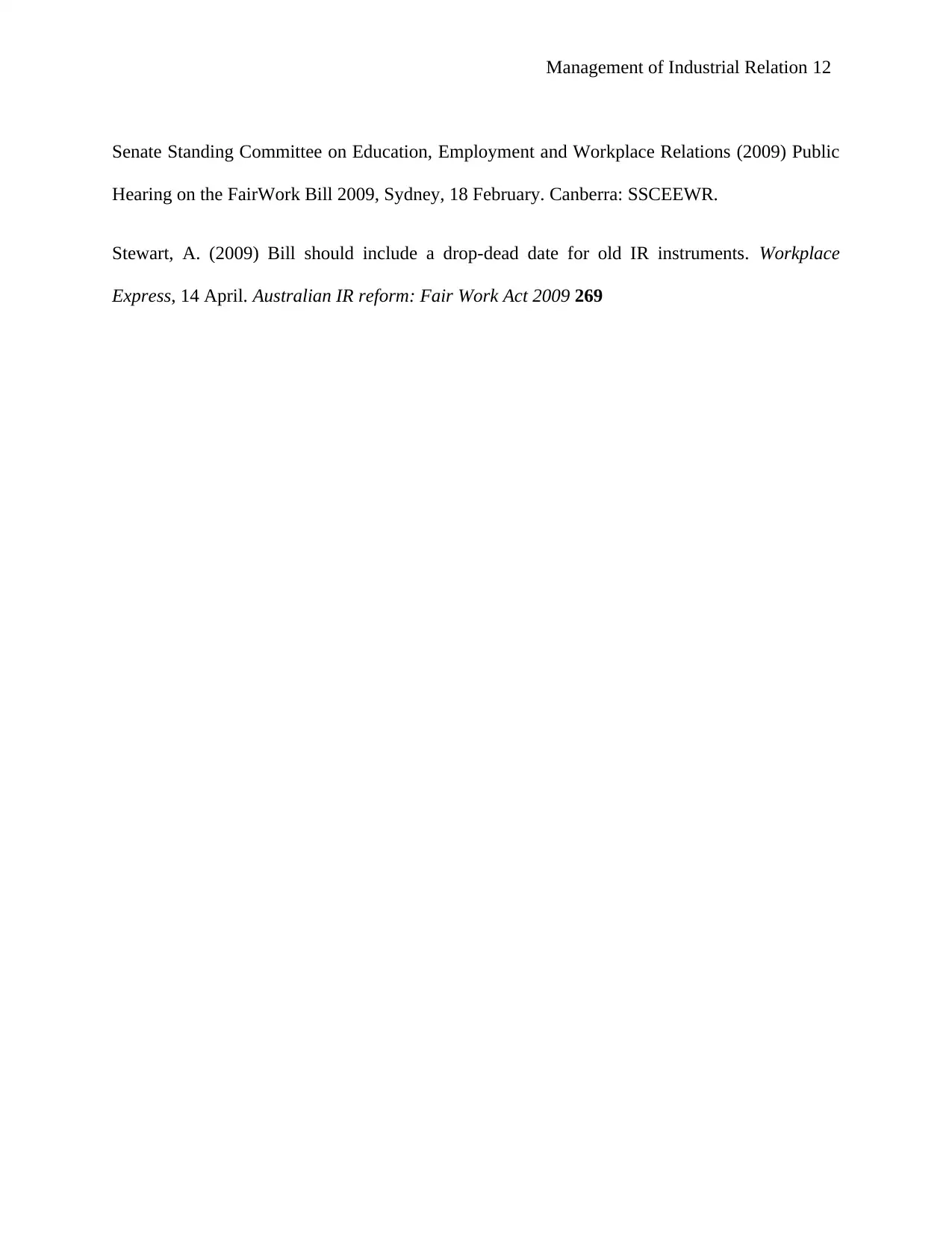
Management of Industrial Relation 12
Senate Standing Committee on Education, Employment and Workplace Relations (2009) Public
Hearing on the FairWork Bill 2009, Sydney, 18 February. Canberra: SSCEEWR.
Stewart, A. (2009) Bill should include a drop-dead date for old IR instruments. Workplace
Express, 14 April. Australian IR reform: Fair Work Act 2009 269
Senate Standing Committee on Education, Employment and Workplace Relations (2009) Public
Hearing on the FairWork Bill 2009, Sydney, 18 February. Canberra: SSCEEWR.
Stewart, A. (2009) Bill should include a drop-dead date for old IR instruments. Workplace
Express, 14 April. Australian IR reform: Fair Work Act 2009 269
⊘ This is a preview!⊘
Do you want full access?
Subscribe today to unlock all pages.

Trusted by 1+ million students worldwide
1 out of 12
Related Documents
Your All-in-One AI-Powered Toolkit for Academic Success.
+13062052269
info@desklib.com
Available 24*7 on WhatsApp / Email
![[object Object]](/_next/static/media/star-bottom.7253800d.svg)
Unlock your academic potential
Copyright © 2020–2025 A2Z Services. All Rights Reserved. Developed and managed by ZUCOL.





